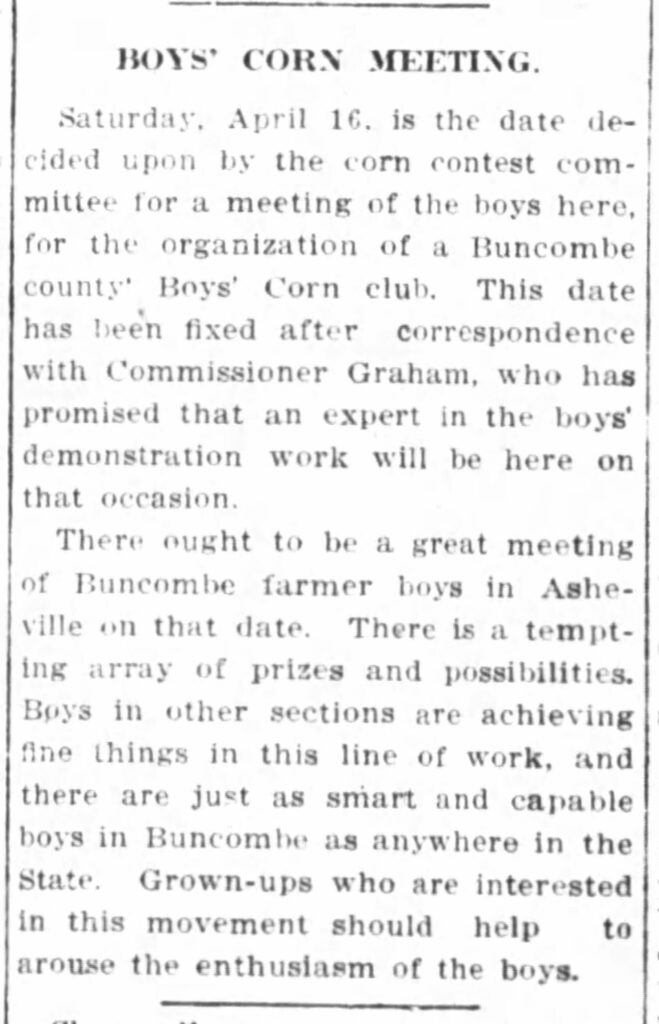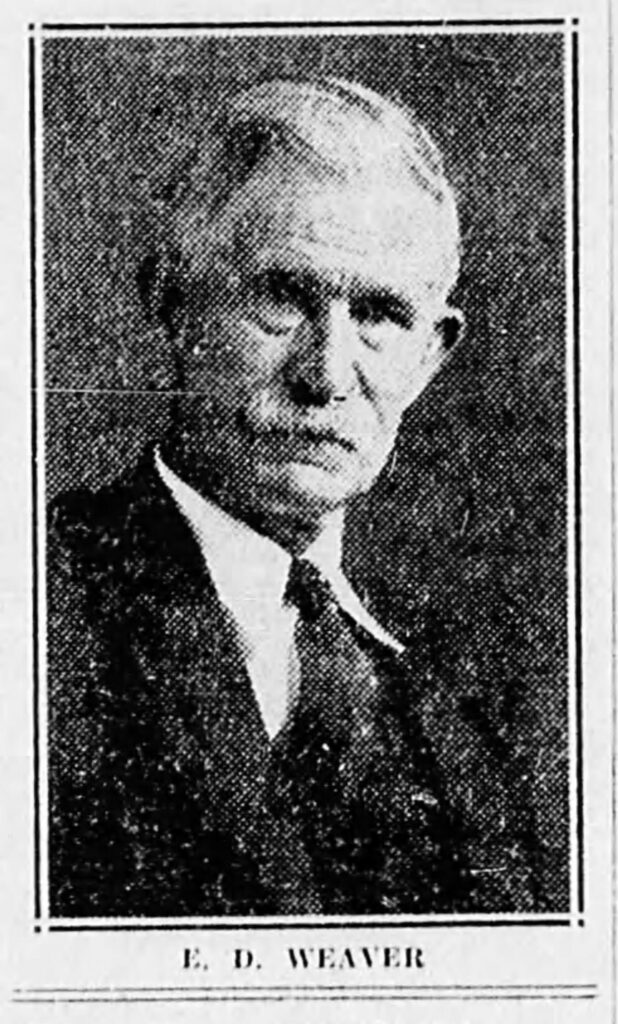Buncombe County Cooperative Extension – Beginnings to 1920
go.ncsu.edu/readext?1044452
en Español / em Português
El inglés es el idioma de control de esta página. En la medida en que haya algún conflicto entre la traducción al inglés y la traducción, el inglés prevalece.
Al hacer clic en el enlace de traducción se activa un servicio de traducción gratuito para convertir la página al español. Al igual que con cualquier traducción por Internet, la conversión no es sensible al contexto y puede que no traduzca el texto en su significado original. NC State Extension no garantiza la exactitud del texto traducido. Por favor, tenga en cuenta que algunas aplicaciones y/o servicios pueden no funcionar como se espera cuando se traducen.
Português
Inglês é o idioma de controle desta página. Na medida que haja algum conflito entre o texto original em Inglês e a tradução, o Inglês prevalece.
Ao clicar no link de tradução, um serviço gratuito de tradução será ativado para converter a página para o Português. Como em qualquer tradução pela internet, a conversão não é sensivel ao contexto e pode não ocorrer a tradução para o significado orginal. O serviço de Extensão da Carolina do Norte (NC State Extension) não garante a exatidão do texto traduzido. Por favor, observe que algumas funções ou serviços podem não funcionar como esperado após a tradução.
English
English is the controlling language of this page. To the extent there is any conflict between the English text and the translation, English controls.
Clicking on the translation link activates a free translation service to convert the page to Spanish. As with any Internet translation, the conversion is not context-sensitive and may not translate the text to its original meaning. NC State Extension does not guarantee the accuracy of the translated text. Please note that some applications and/or services may not function as expected when translated.
Collapse ▲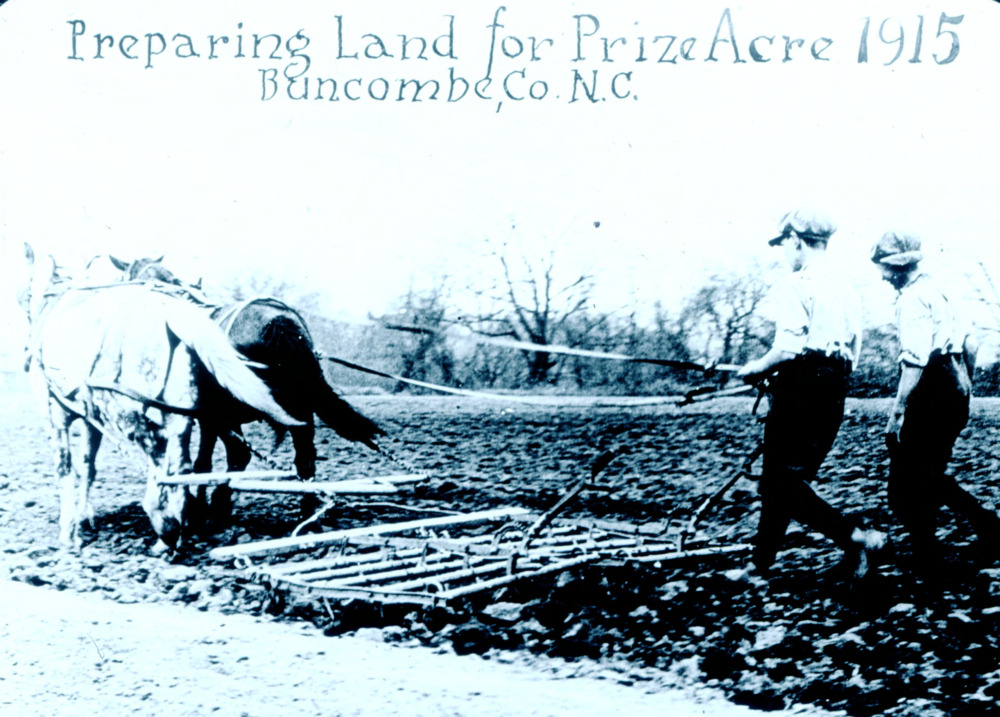
Preparing Land for Prize Acre – 1915
University Archives Photograph Collection. Glass negatives and Lantern Slides (UA023.031). Special Collections Research Center at NC State University Libraries. Digital collections: Rare and Unique Materials.
2025 marks the 115th year of Cooperative Extension work in Buncombe County. Despite its lengthy history, many factors and independent agencies contributed to the creation of North Carolina Cooperative Extension. Join us this year as each month we look back on the decades of agricultural progress and Cooperative Extension work in Buncombe County from the late 19th century to present day.
Buncombe County Cooperative Extension is a satellite office of NC State University, in partnership with NC A & T University, local county government, state government, and the USDA that supports agriculture in Buncombe County, complete with the 4-H Club, serving everyone from the commercial farmer to the home gardener and community members through various research-based programs, information, and education.
Following is a timeline of notable events showcasing agricultural progress in North Carolina and the development of North Carolina Cooperative Extension in Buncombe County.
1853 – The first North Carolina State Fair is held in Raleigh, exhibiting livestock, produce, and farm equipment in an effort to promote better farming practices.
1861 – Abraham Lincoln is inaugurated the 16th president of the United States. At the time 45% of North Carolinians are listed as farmers on the 1860 US Census.
1862 – The Morrill Land-Grant College Act, signed by Abraham Lincoln, establishes Land Grant universities. Offering a “chance for the children of the working man to secure a higher education, (1)” these universities are to offer courses in agriculture and mechanical arts.
1878 – The NC Department of Agriculture describes that “Buncombe County does not grow cotton. The acreage of wheat is steadily increasing. The interest in fruit growing is rapidly increasing, especially that of apples. The price of farm land in this county varies, when under cultivation, from $5 to $50 per acre. The very finest tobacco is raised, averaging 600 lbs to the acre…The character of labor remains about the same, men’s wages vary from $6 to $10 per month…(2).”
1880 – October 3 – The Western North Carolina Railroad reaches Asheville with the first train arriving from Salisbury. In the years following, train travel brings an influx of people and activity to Asheville, resulting in an increase in population and urbanization.
1887 – The Hatch Act is signed into law, enabling land-grant universities to organize agricultural experiment research stations.
1889 – The first agricultural classes are held at North Carolina College of Agriculture and Mechanic Arts. Now known as NC State University, it is the state’s first Land-Grant institution. Work of the agricultural experiment stations, already underway, is transferred to the university, partnered with the North Carolina Department of Agriculture.
1890 – August 30 – The second Morrill Act is signed into effect by President Benjamin Harrison, creating Land-Grant institutions and educational opportunities in agriculture for African American citizens.
September 30 – The Asheville Daily Citizen newspaper announces: “In order to bring the work of the experiment station more directly before the farmers of various localities of the state…it has been decided to establish sub-stations in about eight or nine representative localities. These points will be three in the section east of Raleigh, three in the central section of Raleigh, and two in the mountainous section. These sub-stations will try experiments in agriculture (3).”
Today, two research farms exist in Western North Carolina, the Mountain Horticultural Crops Research and Extension Center in Mills River, Henderson County, and the Mountain Research Station in Waynesville, Haywood County.
1891 – NC A &T (North Carolina Agricultural and Technical State University) is founded to “teach practical agriculture and mechanic arts and such branches of learning as relate there to, not excluding academic and classical instruction (4)” to North Carolina’s African American citizens.
1895 – December 24 – George Vanderbilt officially opens the Biltmore House to invited guests. Agricultural endeavors of the Biltmore Estate in its early years include a dairy farm, livestock, crops, and forestry.
1907 – James A Butler becomes North Carolina’s first county agent. A native of Davie County, employed by the USDA, he performs farm demonstration work in Iredell County.
1909 – North Carolina becomes the first state to partner with the USDA when a memorandum of understanding is signed between the two parties allowing Land-Grant universities to conduct farm demonstration work. As part of these efforts, boys’ “Corn Clubs” are organized where young boys used the latest techniques to grow corn on a one acre plot of land. These clubs were the forerunner to today’s 4-H clubs, the first being in Ahoskie, Hertford County, North Carolina.
1910 – Interest in forming a Boys’ Corn Growing Club is published in the Asheville Times newspaper.
1910 – Ethan Douglas (E.D.) Weaver is selected as the Superintendent of Demonstration Farm Work by the Buncombe County Board of Commissioners, becoming the first county farm agent west of the Blue Ridge. Born April 10, 1856 in Buncombe County, he serves as a farm agent from 1910 until 1920.
1911 – The success of the boys’ Corn Clubs leads to Girls’ Tomato Canning Clubs, paving the way for today’s Cooperative Extension Family and Consumer Sciences programs.
1914 – May 8 – President Woodrow Wilson signs the Smith-Lever Act into effect, formally establishing the Cooperative Extension System in each state.
September 21 – One of the county’s first organized agricultural fairs is held in West Asheville. Organized by Edward Walton (E.W.) Pearson, a prominent citizen of Asheville, and running yearly from 1914 to 1947, the fair provides an opportunity for the region’s African American citizens to showcase their agricultural talents.
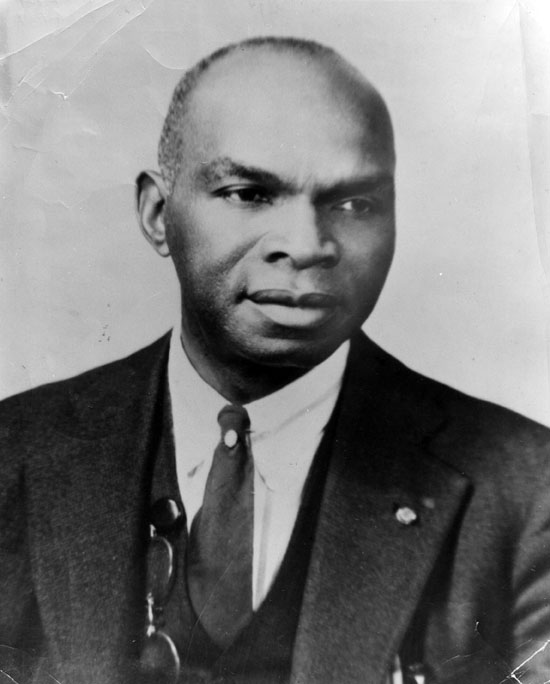
Edward W. Pearson Sr
West Asheville History Project
Buncombe County Special Collections
https://westashevillehistory.org/edward-w-pearson-sr/
1915 – 1915 brings an influx of activity to Cooperative Extension work in Buncombe County. While E.D. Weaver serves as the county farm agent, three women, Mrs. John LeFevre, Miss Hattie Dowd, and Miss Jennie Whitaker, work as Home Demonstration Agents.
Volume 1, Issue 8 of The Extension Farm News describes Buncombe County as having “the second highest number of boys enrolled in the county’s Corn Club with 138 compared to Wake county, top in the state, with 150 enrollees.”(4)
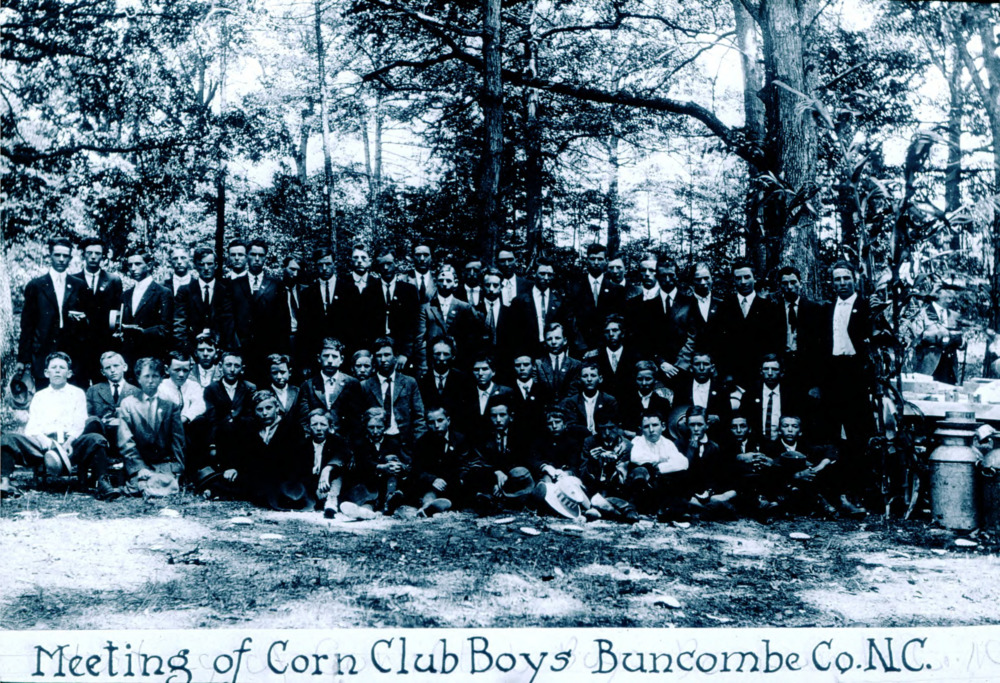
Boys’ Corn Club – Buncombe County – 1915
University Archives Photograph Collection. Glass Negatives and Lantern Slides (UA023.31).
Special Collections Research Center at NC State University Libraries.
NC State University Libraries’ Digital Collections: Rare and Unique Materials.
1917 – April – America’s involvement in World War I begins when the US House of Representatives declares war on Germany. Draft registration begins June 5, with over 100% of eligible men in North Carolina registering, indicating that many were dishonest about their actual age in order to take part.
1918 – A new, deadly, strain of the flu makes its way through the country with North Carolina no exception. Young, healthy adults between the ages of 20 and 40 are hardest hit, with many losing their lives just days after the onset of symptoms.
As the 1918 flu pandemic rages on, The Fourth Annual Report of the NC Ag Extension Service showcases the work of Mrs. Hanamon, Home Demonstration Agent for Buncombe County, and Mrs. JH Henley, with the Influenza Relief Committee in the below article:

Fourth Annual Report of the North Carolina Agriculture Extension Service of the Year Ended June 30, 1918. P. 57-58.
Cooperative Extension Service. Annual Reports (UA102.002).
Special Collections Research Center at NC State University Libraries.
The current staff of Buncombe County Cooperative Extension continues serving the community in times of need, most recently working at various locations in the county distributing food and supplies, providing fencing materials and other needed assistance to those affected by Hurricane Helene.
The 1920s brought both prosperity and despair to western North Carolina. From the increasing use of tractor farming to the stock market crash of 1929, this decade brought great change to both rural and urban areas. Join us in February as we explore the 1920s and highlight the changing times of agriculture and Cooperative Extension work in Buncombe County.
Sources:
(1) Rasmussen, Wayne D. Taking the University to the People: Seventy-Five Years of Cooperative Extension. Iowa State University Press, 1989.
(3) “Out on the Farm.” The Asheville Daily Citizen, 30 Sept. 1890, pp. 2–2, https://www.newspapers.com/image/202716375/match=1&terms=%22Experiment%20Station%22.
Accessed 13 Dec. 2024.
(4) “A&T History.” North Carolina A&T State University, North Carolina Agricultural And Technical State University, 2024, www.ncat.edu/about/history-and-traditions/index.php.
___________________________________________________________________________
“Agents for Home Demonstration Work in North Carolina.” NC State University Libraries’ Rare and Unique Digital Collections, North Carolina State University, d.lib.ncsu.edu/collections/catalog/1915agents#?c=&m=&cv=&xywh=-1171%2C-346%2C6290%2C6897.
Accessed 13 Dec. 2024.
“Boys’ Corn Meeting.” The Asheville Times, 8 Apr. 1910, pp. 4–4, https://www.newspapers.com/image/59339514/?match=1&terms=Boys%20Corn%20Meeting
Accessed 13 Dec. 2024.
Edward W. Pearson Sr. 1937. Asheville, North Carolina. Photograph from Buncombe County Special Collections – Buncombe County Library.
“Extension Farm-News Vol. 1 No. 8, April 3, 1915.” NC State University Libraries’ Rare and Unique Digital Collections, NC Department of Agriculture, North Carolina Experiment Station, 3 Apr. 1915, d.lib.ncsu.edu/collections/catalog/S1E9-v1n8-1915-04-03#?c=&m=&cv=&xywh=-2439%2C-1%2C8103%2C6052.
“Fourth Annual Report of the North Carolina Agricultural Extension Service of the Year Ended June 30, 1918.” NC State University Libraries’ Rare and Unique Digital Collections, North Carolina State University, 1919, d.lib.ncsu.edu/collections/catalog/ua102_002-001-bx0016-011-001#?c=&m=&cv=57&xywh=-925%2C-313%2C5675%2C6223.
Freman, Trevor. “Through Rock and Time: The Railroad Comes to the Mountains – Asheville Museum of History.” Asheville Museum of History –, Asheville Museum of History, 24 Feb. 2023, www.ashevillehistory.org/through-rock-and-time-the-railroad-comes-to-the-mountains/#:~:text=After%20another%20year%20of%20continuous,Salisbury%20on%20October%203%2C%201880.
Marshall, Jackson R, et al. “World War I.” NCpedia, 2006, www.ncpedia.org/world-war-i-part-2-north-carolinas.
Moore, Justin – Director of Marketing and Communications. “Extension History and Milestones.” NC State Extension News, North Carolina State University, www.ces.ncsu.edu/extension-history-and-milestones/
Accessed 13 Dec. 2024.
“Morrill Act (1862).” National Archives and Records Administration, National Archives and Records Administration, www.archives.gov/milestone-documents/morrill-act#:~:text=The%20Second%20Morrill%20Act%20of,was%20not%20restricted%20by%20race.
Accessed 13 Dec. 2024.
“Mr. James A Butler Dead.” The Evening Tribune, 19 Feb. 1908, pp. 1–1, https://www.newspapers.com/image/61960555/
Accessed 13 Dec. 2024.
NC State Fair: Agriculture (from Tar Heel Junior Historian) | Ncpedia, www.ncpedia.org/government/fair/agriculture
Accessed 13 Dec. 2024.
“Report on the General Condition of the Agricultural Interests of North Carolina (NC Dept. of Agriculture. Circular No.28).” NC State University Libraries’ Rare and Unique Digital Collections, Mar. 1878, d.lib.ncsu.edu/collections/catalog/NCSU608036_20220720_38061#?c=&m=&cv=13&xywh=-903%2C-313%2C5684%2C6233.
Staff Reports. “Renaissance Man: Edward W. Pearson.” The Urban News, 14 Feb. 2014, theurbannews.com/lifestyles/2014/renaissance-man-edward-w-pearson/.
Walbert, David. “Occupations in North Carolina in 1860.” NCpedia, 2009, www.ncpedia.org/occupations-north-carolina-1860.
“Weaver Family Holds Reunion.” The Asheville Citizen Times, 12 Aug. 1932, pp. 8–8, https://www.newspapers.com/image/195707139/?match=1&terms=E%20D%20Weaver
Accessed 13 Dec. 2024.





